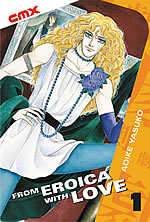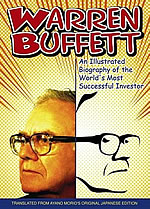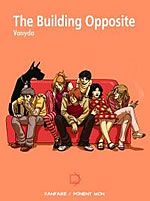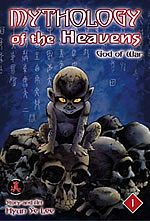PG Tips No. 15:
Manga Special
Here is a selection of the highlights from the recent manga releases, in a manga special of my regular PG Tips review column.
Monster Vol 9
by Naoki Urasawa
Viz Media
Who needs overlong TV teases like Lost when you can plunge into this fiendish medical-demonic thriller, terrifying and touching right through to its climax in volume 18. I just read the latest in English, volume 9, and was stunned by Urasawa’s switch to sepia cartoonish style for an utterly creepy Czech children’s book - and later by an electrifying build-up worthy of De Palma as the Monster, beautiful yet lethal Johan, stares into the ‘blind’ eyes of his latest victim.
Dragon Head Vol 7
by Minetaro Mochizuki
Tokyopop
Think this wraps up in 9 volumes and the latest, volume 7, starts to reveal the extent and maybe the causes behind the decimation of Japan. Four young survivors fly in search of the long-dormant Mount Fuji, finding vast black clouds and flaming larva flows. But where the volcano should be is a gaping hole. In one sequence their helicoptor flies down into the darkness, which eventually fills a two-page spread. Simply the darkest, deepest realist post-apocalypse manga you’ll find today.
Spiral
by Sakura Mizuki
Dark Horse
A terrifying sequel takes you beyond The Ring movies. The Ring cycle of creepy cult Japanese movies started life as a series of novels written by horror-meister Koji Suzuki. To find out what happens next in this modern urban legend, there’s no need to wait for the big screen sequel, because the next novel Rasen or Spiral has been adapted into a manga graphic novel. This episode builds on all that has gone before - the lethal video tape, the tragic history and curse of Sadako, the holiday cottage and the well - but it also introduces a more scientific, but equally disturbing, investigation into what The Ring virus might be and the bizarre ways in which it is evolving. As a friend of the late Ryuji Takayama, a recent victim of The Ring, Dr. Mitsuo Ando is determined to dig deeper into this medical mystery. His sense of terror escalates when Takayama’s pregnant female assistant vanishes, only to be found later, dead inside a ventilation shaft with no sign of her newborn child. There’s a chilling concept behind Sadako’s return in this book: the only way for anyone to cheat her curse may be to help this virus to multiply still further. Beyond good or evil, we get more of an understanding of what Sadako wants, her primal survival instinct and her need for everyone to remember her existence.
On his first major project, artist Sakura Mizuki draws with surgical precision and paces the shocks very effectively as you turn the pages. He is especially clever at interweaving black backgrounds bleeding off around his frames to signal when the story shifts from the present into flashbacks, from reality into nightmares. Spiral provides some answers but also raises troubling questions about how this seemingly unstoppable virus is mutating. So much so that I found this book makes you feel physically uncomfortable after you’ve finished it, because you can’t shake the feeling that maybe this manga itself might be infectious. Could it too be spreading the curse to everyone who reads it?
Who is Sakura Mizuki? The truth is it’s really a pen-name of Hisaki Sakuri. Since crafting Spiral back in 1999, he has been writing his own gritty thriller serial Dinner Time. This is debuting in English in advance of its Japanese publication courtesy of the new Manga Mover anthology from Boychild Productions.
From Eroica With Love Volume 1
by Yasuko Aoike
DC/CMX
A Seventies camp thriller art thefts, tight jeans and unrequited passions, Eroica Yori Ai O Komete, translated as From Eroica With Love, is a long-running, best-selling classic of shojo or girls’ manga from that decade of over-the-top fashions, the Seventies. Finally, it’s arrived in English courtesy of DC Comics’ new manga line CMX, nearly thirty years since Yasuko Aoike concocted her blend of comedy heist movie and tantalising gay romance for Akita Shoten’s monthly Princess magazine.
Reflecting the Japanese fascination at the time for the ‘exotic’ locales of Britain and Europe, Aoike’s loveable rogue hero is Dorian Red Gloria, a flamboyant wealthy English Earl. Despite his considerable wealth, he much prefers the thrill of stealing the art treasures he covets rather than simply paying for them. Ravishingly attractive, resembling those curly-locked rock gods Robert Plant or Roger Daltrey, Dorian moonlights as Europe’s most wanted international art thief, codenamed ‘Eroica’. A connoisseur of beauty in all its forms, Dorian shamelessly flouts society’s conventions in other ways by being openly homosexual. In this first three-chapter volume, apart from paintings and sculpture the objects of his desire include the young, inexperienced scholar Caesar Gabriel and especially the uptight, irritable German NATO agent, Major Klaus von dem Eberbach. Klaus has been sent to capture Eroica and becomes both Dorian’s arch nemesis and principal love interest.
These are the ingredients for a unique mix of unpredictable twist-and-turn caper and Carry On-like romp. Dorian’s cunning schemes somehow keep him one step ahead of Klaus’s efforts to catch him, while Dorian’s teasing yet tender sexual advances come up against Klaus’s Teutonic stiffness, putting him in some hilarious compromising situations. I suppose it’s unavoidable that from today’s post-modern perspective reading From Eroica With Love will seem like you’ve stepped through a time-warp back to the Seventies. But if you adjust to this shojo genre’s idiosyncrasies of wildly exaggerated emotions, bouquets of flowers and big twinkling eyes, this is a hugely entertaining retro farce, a keen battle of wits and perhaps the greatest saga of unrequited love in all of comics.
In its first run, there were 14 stories and 8 shorter ‘side stories’ of From Eroica With Love, collected into 19 tankobon books between 1976 and 1988. After a few years on other projects, Yasuko Aoike returned to her hit series in 1995 and has produced a further 5 stories and 3 side stories, compiled into another 9 volumes so far. Over the years Dorian and Klaus have built up a huge online following in the West (start at www.eroicafans.org), where fans summarise every episode, share scanned pages, create their own art and fiction, cast a hypothetical film and rate Dorian’s outrageous outfits.
Blue
by Kiriko Nananan
Fanfare/Ponent Mon
When friendship between two schoolgirls blossoms into romance. School is almost over and summer vacation beckons. Blue is the colour of the uniforms of the girls at Hijiri High, and of the sea nearby which Kayako escapes to with her classmate Masami. Blue is also the mood of this sensitive, sensual exploration of two very different teenage girls, who become friends and perhaps more than friends. Kayako’s fascination with an outsider back after a mysterious suspension deepens into friendship, adulation and a sweet and painful love, after she learns about Masami’s pregnancy and abortion. Her subtle kindnesses toward Masami - a candy on her lips, a sleepover while her parents are away, cutting her hair short, holding hands, stolen kisses - build up Kayako’s hopes, but Masami keeps more secrets which she has yet to discover.
Kiriko Nananan takes the lightest of touches with her tale, avoiding melodrama or prurient expectations and focusing on the affections and awkwardness between her two heroines. Her beautiful page layouts contrast sharp, clear interiors of the school, subway or seashore with the fragile human contours of young faces and bodies and the shifting shapes of their black hair. The girls’ dialogues slip from public classroom chatter to more private intimacies, perfectly capturing the emotions behind the simplest of conversations. At times Kayako’s thoughts become so intense that their floating typeset phrases blank out all imagery in the panels, even emptying a whole page. Like the rush of first love, Blue is unforgettable.
Warren Buffett: An Illustrated Biography
by Ayano Morio
John Wiley & Sons
America’s ‘superhero of finance’ now in his own manga biography. Fortune magazine called him "The Oracle of Everything". CNN hailed him as "the most successful investor of the 20th century". I knew next to nothing about Warren Buffett, let alone investing in stocks, until I read this biographical manga. Growing up during America’s Great Depression instilled Buffett’s strong drive to get rich. Honest, conservative, clever with numbers, he started young. Aged only 6, he pocketed 5 cents profit from every six Coke bottles he sold; by the age of 14, he was making $175a week from his newspaper route. Benjamin Graham’s ‘How To’ book The Intelligent Investor came as a revelation when Buffett was 19. He had such faith in Graham’s advice, he was determined to study under him and eventually work for him. But soon Buffett devised his own low-tech ‘rules for success’, with which he outperformed Wall Street and amassed the world’s second largest individual fortune. Ayano Morio smoothly distils Buffett’s life-story into her 160-page graphic novel. Although she has to be wordy in places, this is no dry textbook and she skilfully emphasises the drama and wisdom behind Buffett’s success. I found his experiences and the lessons he learned from them fascinating, even quietly inspiring. Rather like the man himself.
The Building Opposite
by Vanyda
Fanfare/Ponent Mon
These days in cities large and small, people live on top of each other, literally, and yet can remain total strangers. All it takes though is a friendly hello, a lift back from the shops, locking yourself out of the flat, and relationships start to build. In this block, there are two twenty-something lovers on the top floor, an older, more jaded couple beneath them ruled by their big dog, and a pregnant single mother and her young boy below them. The separate stories and lives of these three very different households gradually intersect and entwine into an amusing, deftly observed suite of apartment life. Vanyda is a young French woman author, who is strongly inspired by both bande dessinée and Japanese comics and anime and has been acclaimed as a new member of the ‘Nouvelle Manga’ movement which focuses on tales of everyday life. I’ve been waiting for her debut book to make it into English; don’t miss this quietly powerful ensemble piece.
Mythology Of The Heavens
by Hyun Se Lee
CPM Press
The violence and sexual content in this manhwa fantasy set in Korea’s primordial past created a storm there in 1997, when the artist was prosecuted and fined for violating the Youth Protection Law, only to be eventually found not guilty. Judge for yourself in his first volume, God of War, packing a chunky 328 pages.
Paul Gravett’s reviews of Monster and Dragon Head were written for iaLink, a national monthly publication that focuses on contemporary Asian American culture. The next four reviews first appeared in Neo, the UK magazine of Manga, Anime, Asian Films, Games & more. The two final reviews first appeared in Comics International, the UK magazine of comics, graphic novels and manga.




















